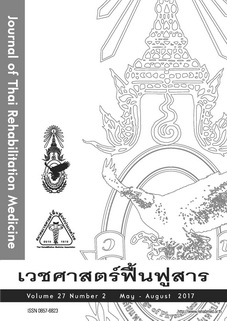การศึกษาหาความชุกของโรคไฟโบรมัยอัลเจียในผู้ป่วยกลุ่มอาการปวดกล้ามเนื้อมัยโอฟาสเชี่ยลเรื้อรัง
การศึกษาหาความชุกของโรคไฟโบรมัยอัลเจียในผู้ป่วยกลุ่มอาการปวดกล้ามเนื้อมัยโอฟาสเชี่ยลเรื้อรัง
Keywords:
fibromyalgia, chronic myofascial pain syndrome, prevalenceAbstract
Objectives: To study the prevalence of fibromyalgia (FM) in chronic myofascial pain syndrome (MPS) patients.
Study design: Descriptive study
Setting: Outpatient clinic, Physical Medicine and Rehabilitation Department, Siriraj hospital.
Subjects: Seventy patients, aged 20-60 years who were diagnosed with MPS more than 3 months, and visited between september 2012 to september 2013.
Methods: All the subjects were face-to-face interviewed with a screening tool for the diagnosis of FM based on the ACR 2010 criteria validated and translated into Thai version. Including factors that might influence the course of the disease were also reviewed.
Results: Eighteenth out of 70 patients of chronic MPS (25.7%) fulfilled the criteria of FM (95% Confidence Interval: 16.9% - 37.0%). The most common site of pain found in those with FM was neck (50%) whereas in those without FM was either side of shoulder (51.9%). Stress as an aggravating factor was found more in those with FM than in those without FM (12/18 and 14/52, p=0.003). No statistical significance in age, sex, pain duration and average pain severity between these two groups.
Conclusion: The prevalence of fibromyalgia in patient with chronic myofascial pain syndrome was 25.7%.
References
2. Goldenberg DL, Clauw DJ, Fitzcharles MA. New concepts in pain research and pain management of the rheumatic diseases. J Sem Arthrit. 2011;41:319-34.
3. Wolfe F. Fibromyalgia. Rheum Dis Clin North Am. 1990;16:681–98.
4. Chaitow L. Fibromyalgia syndrome a practitioner’s guide to treatment, 3rd edition, London: Churchill Livingstone. 2009.
5. Cakit BD, Taskin S, Nacir B, Unlu I, Genc H, Erdem HR. Comorbidity of fibromyalgia and cervical myofascial pain syndrome. Clin Rheumatol. 2010;29:405–11.
6. Prateepavanich P, Aromdee E, Chaudakshetrin P, Laurujisawat P, Poungvarin N, Leartsakulpanitch J, et al. Modifications of the American College of Rheumatology 2010 preliminary diagnostic criteria for fibromyalgia syndrome and measurement of symptom severity as a screening tool for its diagnosis [ACR 2010 FMS-STD]: lessons learned from the process of translation and validation into a Thai version. J Musculoske Pain. 2014;22:7-12.
7. Clauw DJ. Fibromyalgia: an overview. The American Journal of Medicine. 2009;122:S3–S13.
8. Ge HY. Prevalence of myofascial trigger points in fibromyalgia: the overlap of two common problems. Curr Pain Headache Rep. 2010;14:339–45.
9. Borg-Stein J, Stein J. Trigger points and tender points: one and the same? Does injection treatment help? Rheum Dis Clin North Am.1996;22:305-22.
10. Staud R. Peripheral pain mechanisms in chronic widespread pain. Best Pract. Res. Clin. Rheumatol. 2011;25:155-64.
11. Sarzi-Puttini P, Atzeni F, Mease PJ. Chronic widespread pain: from peripheral to central evolution. Best Pract Res Clin Rheumatol. 2011;25:133-39.
12. Affaitati G, Costantini R, Fabrizio A, Lapenna D, Tafuri E, Giamberardino MA. Effects of treatment of peripheral pain generators in fibromyalgia patients. Eur J Pain. 2011;15:61-69.
13. Gerwin RD. A study of 96 subjects examined both for fibromyalgia and myofascial pain. J Musculoskel Pain. 1995;3:121.
14. Marques AP, Ferreira EAG, Matsutani LA, Pereira CAB, Assumpção A. Quantifying pain threshold and quality of life of fibromyalgia patients. Clin Rheumatol. 2005;24:266–71.
15. Rachlin ES. History and physical examination for regional myofascial pain syndrome. In: Rachlin ES, editor. Myofascial pain and fibromyalgia: trigger point management. St. Louis: Mosby; 1994. p.159-72.
16. Rosomoff HL, Fischbain DA, Goldberg M, Santana R, Rosomoff RS. Physical findings in patients with chronic intractable benign pain of the neck and/or back. Pain. 1989;37:279-87.
17. Simons DG, Travell JG, Simons LS. Trapezius muscle. In: Johnson E, editor. Travell & Simons’ myofascial pain and dysfunction: the trigger point manual. vol. 1. upper half of body. 2nd ed. Baltimore: Williams & Wilkins; 1999. p. 278-307.
18. Sola AE, Kuitert JH. Myofascial trigger point pain in the neck and shoulder girdle. Northwest Med. 1955;54:980-84.
19. Sola AE, Rodenberger ML, Gettys BB. Incidence of hypersensitive areas in posterior shoulder muscles: A survey of two hundred young adults. Am J Phys Med. 1955;34:585-90.
20. Reilly PA, Littlejohn GO. Peripheral arthralgic presentation of fibrositis/fibromyalgia syndrome. J Rheumatol. 1992;19281-83.






